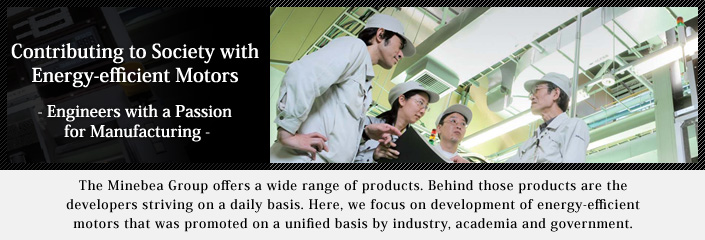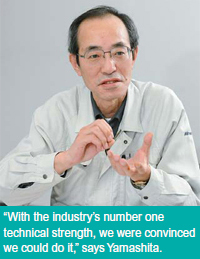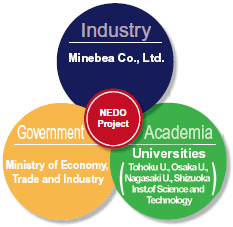2011

(Posted Sept. 2011)
Becoming champions in the energy-efficient motor field
As global environmental and energy problems intensify, energy conservation has become an urgent challenge for society as a whole. In what would become the company's first NEDO-designated project (see column), Minebea began developing magnets for small, energy-efficient motors in May 2009.
Motors of all types and sizes are used in a wide range of everyday equipment, including automobiles and electrical appliances for the home. Today, over nine billion motors are in annual use around the world in many different locations and applications, and approximately 57% of the electric power consumed in Japan is used to power motors. If the efficiency of domestically powered motors could be increased by 1%, the energy efficiency impact would equal that of a reactor in a nuclear power plant, and this field is attracting attention as having great importance in solving the problems of global warming and energy. The component that determines the motor's efficiency—the magnet—is the key. Increasing the magnetic force is directly related to boosting the efficiency of the motor.
The originator of the project, Fumitoshi Yamashita, explains the motive behind the project: "Motors utilizing magnets have been in use since around the 1960s, but while the prevailing demand at that time was for horsepower, recent years have seen an increasing need for products that are small and efficient, and have long operating lives and low environmental impact. Amid this trend, when we considered what it was that we in our position could and must do, the resulting idea was the development of magnets for small, energy-efficient motors. Since we must work in any case, we wanted to do something that would benefit the world."
Of course, simply increasing the magnetic force of the magnet does not make for an energy-efficient motor. This is because the stronger the magnet used, the more difficult it becomes to use the motor. When the magnetic force of a more powerful magnet is transmitted as torque (the power to rotate the shaft), the additional force manifests as vibration that can cause excessive noise, and on the contrary makes for a motor with poor energy efficiency. To efficiently transmit powerful magnetic force to the shaft as torque, the magnetic flux from the magnet's surface (the flow of magnetism from the magnet) must be regulated and its power controlled in complex ways. Magnetic flux control stood as a major obstacle to the practical implementation of energy-efficient motors.
 According to Yamashita, "Regardless of how high the efficiency is, if the motor is extremely noisy, one cannot say it is an excellent product. Those of us in corporate research and development must grasp the needs of customers who will ultimately use the product. However, that is why our company has an advantage in this area: we are not a specialized magnet manufacturer, but rather are engaged in magnet development based on a comprehensive understanding of motors. We are confident that we have, without a doubt, the industry's number one technical strength in this field, and we were convinced we could do it."
According to Yamashita, "Regardless of how high the efficiency is, if the motor is extremely noisy, one cannot say it is an excellent product. Those of us in corporate research and development must grasp the needs of customers who will ultimately use the product. However, that is why our company has an advantage in this area: we are not a specialized magnet manufacturer, but rather are engaged in magnet development based on a comprehensive understanding of motors. We are confident that we have, without a doubt, the industry's number one technical strength in this field, and we were convinced we could do it."
This is how the magnet development project started. For three years after originating it, Yamashita alone was responsible for all aspects of the project and furthering the research. In January 2009, when it finally appeared that the probability of success had risen to approximately 50%, Yamashita applied for NEDO designation as a Subsidized Innovation Implementation Project. Competition for such designation is keen, and above all, it was Minebea's first application.
"NEDO designation would mean funding, and assistance from universities, which would allow us to enhance our development effectiveness. We were convinced that this research was necessary for future society, and early release of a product to the market was important commercially as well as for contributing to society. Our intention was to become a champion in this area," says Yamashita.
In March 2009, NEDO recognized the research for its originality and significance, and announced its decision to designate the research as a NEDO project. It was the instant when Yamashita's idea as a researcher had created a huge opportunity.
Column "What is NEDO?"
 New Energy and Industrial Technology Development Organization
New Energy and Industrial Technology Development Organization
NEDO's mission as an incorporated administrative agency under the control of the Ministry of Economy, Trade and Industry is "addressing energy and global environmental problems" and "enhancement of Japan's industrial competitiveness."
The core of its activities consists of coordination between industry, government and academia to pro - mote research relating to the development and dissemination of new energy sources and energy-efficient technologies. NEDO delegates re - search and development administration to public research institutes, and provides funding and other support for research and development projects selected through publically invited applications.
In advanced technology development fields that are risky and difficult for private-sector enterprises to enter on their own, NEDO project designation makes possible funding support and more efficient research and development through collaboration with universities. The goal is rapid practical implementation and dissemination of innovative technologies through this sort of collaboration between industry, government, and academia.














